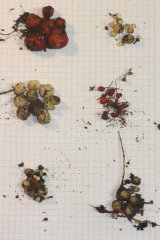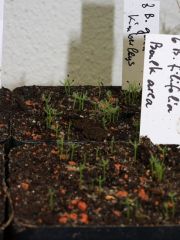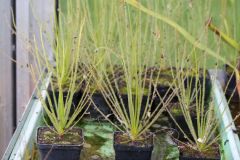
byblis
Full Members-
Posts
110 -
Joined
-
Last visited
-
Days Won
3
byblis last won the day on December 5 2019
byblis had the most liked content!
Profile Information
-
Location
Germany
Recent Profile Visitors
3,834 profile views
byblis's Achievements
8
Reputation
-
la_cava_delle_carnivore started following byblis
-
From time to time (depends on the place of the pot) some drops of water from above or under. And if you are successful you get:
-
I definitely agree in all of silverback´s growing condition! Healthy looking plants in really good light by the way .... Greetings Stefan
-
byblis started following Sean Spence
-
-
Dear all, ages ago I obtained seed of the so called S. purpurea ssp. venosa var. burkei from a location called "Walton Cty., Florida". Nowadays the name is S. rosea and I still maintain some plants of that location. One of the seedlings indeed grew into a hybrid I think between S. rosea and S. flava. Can anybody familiar with that location tell me what kind of S. flava are to be found there, whether that hybrid was seen in nature and perhaps give me some informations. Kindest regards Stefan
-
Hi all, thanks to a good friend (may I post your name here?) I was lucky enough to obtain 3 Setocoris bybliphilus last autumn. They were adult sized with eggs in their abdomen. While transplanting them to my B. gigantea plants one fall onto the substrate of one pot and never was seen again. Another one died within three or four days. Not a good start at all! The very last one survived for months. I fed it with Drosophila the whole winter. Also I had to keep the plants under artificial lights because in the greenhouse during the winter Byblis always gets infected with white mould (hope thats the correct English term!). Now, back in the greenhouse the bugs did multiply and I have them on all adult sized B. gigantea plants. On the plant shown on the photo 4 or 5 bugs live together. Kindest regards Stefan
-
Hi all, wanted to share some pictures of Byblis that I was sowing at the beginning of January: Overview: left to right: B. guehoi Kimberley; B. rorida Lake Campion; B. liniflora Kingston Rest Byblis guehoi Kimberley (a big thanks to the donator here in the forum, contact me in 2 months if you need seed back!) and B. liniflora from Kingston Rest All were soaked in GAB3 for 48 h and sown under high humidity and artifical lights. Thus some of the leaves are curved because I removed the transparent hood last week. In the background some duplicates because that plants I will use to produce a larger amount of seed this year. Kindest regards Stefan
-
16 pounds, too!
-
From my side 11 and 12 pounds for two portions. Regards Stefan
-
Hi, during summer I was lucky enough to obtain a starter pack of Pameridea marlothii. They can easiely be kept on Roridula gorgonias but multiply not as fast as P. roridulae. here are two not very good shots but I thought pictures of this species are not common: A big thanks to the donor and the collector! Kindest regards Stefan
-
Hi Yves, glad to see you had success with this beautiful species! If cultivated well the plant is self fertile. Flowers will last (to 3) days only! regards Stefan
-
Hi friends, today I was as close as 10 km away from one of my favorite bogs and could not resist to visit it during the Pinguicula flowering time. The bog is a calcareous bog (sorry I miss the exact English term) where extremely CO2 rich, cold water emerges from the ground in a couple of small fountains. The whole area is about the size of 4-5 football fields and very hidden. The water has a pH of 7,4 - 7,6 with D. anglica growing in that not acidic water. Plants do not grow to the size they do on peat ground but they are numerous. Also can be found Gentians (spring Gentian already flowered) and Gentiana asclepia... that flowers in autumn. But here are the pics: Overview over the area: The area is covered with open grass that is cutted every year to avoid trees growing over. P. vulgaris is common on the meadow and in full flower now: But the gem in my eyes is a lowland population (relict of the last ice age!) of P. alpina growing around 450 m altitude: An interesting feature is that P. alpina can grow submerged for a while with the rosettes completely under water and just the flowers above water level: Another very interesting point is that both species grow very close together: Left hand is P. vulgaris, right hand P. alpina, distance perhaps 50 cm. I never found hybrids between the species although they flower at the same time. P. alpina is at the end of its flowering, P. vulgaris beginning/in full bloom. Also Primula varinosa can be found there: And in an early stage of growth D. anglica. D. rotundifolia is also there but I didnot take flowers. And my second personal favorite in a very early stage of growth: Utricularia minor! I had to use my hand as background because the small plants are nearly unvisible against the ground. Actually I only could find them because I know them from July/August in flower so I was able to relocate them in a small piece of water perhaps 30 x 50 cm. Please notice the colour of the ground: Again basic calcareous water with a pH of over 7!! Hope you enjoy it! Stefan
-
Hi all, I was asked for growing advice for this beautiful species. Here are some points: Medium: Try an open, peat based medium with Perlite, Vermicullite, clay pearls, sand The ingriedients are not so important but it should be an open mix Most important: Add ONE !! of the lovely yellow graines called Osmocote about one inch deep under the roots for good growth, plants not fed will survive but never show you it´s full beauty with plenty of flowers Climate: Humidity is not so important in may eyes, I keep it dowm to 30 - 40 % rel. humidity on hot, sunny summer days, temps can be as high as you can bring them but not lower then 15 or 16°C during the winter. My oldest plants are now 4 years old and have survived 3 winters now. What I find beneficial is air movement and moist, but not wet substrate. Hope this is not the opposite tips as of Eric´s Homepage! Stefan












